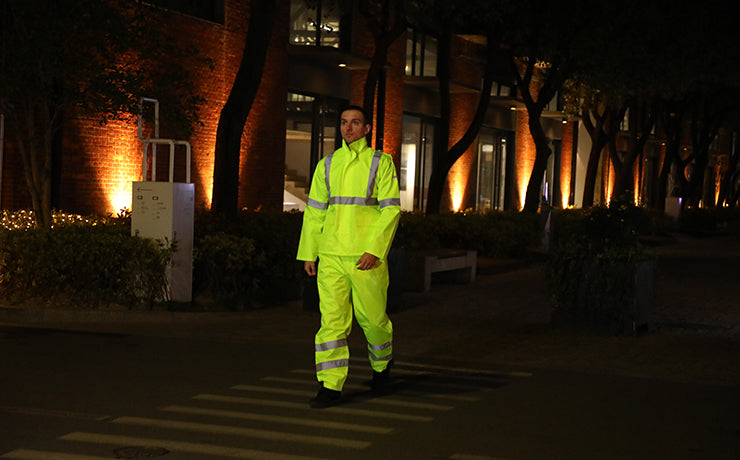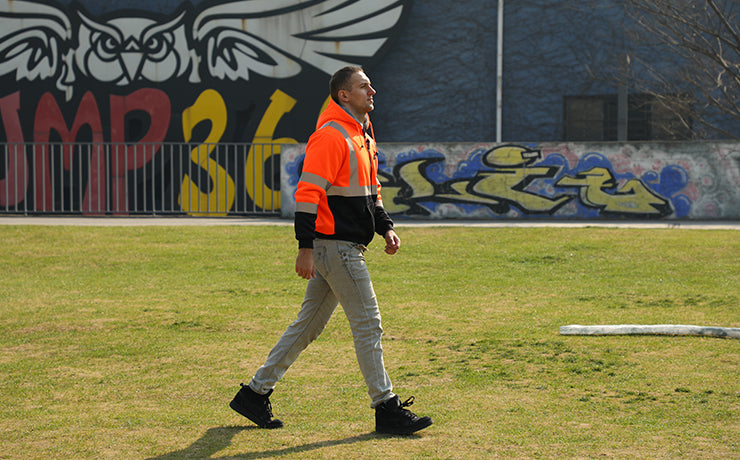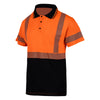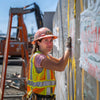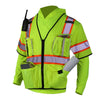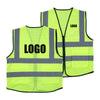ANSI/ISEA 107 Classes and Types: All You Need To Know

Suppose you have purchased high-visibility clothing in the past. So you may already have come across labels mentioning certain ANSI/ISEA 107 classes and types. Those are the standards put forth by ANSI/ISEA 107 to increase worker visibility. Your reflective clothes should adhere to the correct class and type for your safety and to comply with workplace requirements.
Contrary to popular belief, high-visibility clothing items adhere to different requirements. For example, roadside workers (e.g. flaggers) will require some of the highest requirements to be visible to incoming traffic. At the same time, someone working at an offshore oil rig will only need a limited amount of visibility. This post will discuss the different ANSI/ISEA 107 Classes and Types to help you understand the best options for your needs.
ANSI/ISEA 107-2020 Classes and Types
According to ANSI/ISEA 107-2020, there are three classes and three types of high-visibility clothing. Before we dive into what each of these is, here's a table summarizing what they are:
|
Specs |
Type O (Off-Road) |
Type R ( Roadway) |
Type P ( Police and Emergency Response) |
|
Available Classes |
Class 1 |
Class 2, Class 3 |
Class 2, Class 3 |
|
Background Material |
217 in2 |
775 in2 (Class 2) 1240 in2 (Class 3) |
450 in2 (Class 2) 775 in2 (Class 3) |
|
Retroreflective Material |
155 in2 |
201 in2 (Class 2) 310 in2 (Class 3) |
201 in2 (Class 2) 310 in2 (Class 3) |
|
Suitable Jobs* |
Warehouse, driver |
Flagger, roadside, building construction |
Police, firefighters, EMS staff |
*Pick the highest traffic exposure at work as your base class.
To determine what class and type your high visibility gear is, check the product label and descriptions or contact the seller. Our customer service can guide you to find the right product for your unique needs.

ANSI/ISEA 107 Class 1 High Visibility Clothing
Class 1 is the lowest visibility level of all ANSI/ISEA 107-compliant clothing. Wearing Class 1 high-visibility clothes will be sufficient if you're working away from traffic and moving machinery.
Class 1 High Visibility Clothing Requirements
Class 1 high visibility clothes have to include at least 217 in2 of background material and 177 in2 of retroreflective material in 1 in-wide stripes. There are no special arrangements made for smaller-sized workers in this category.
Class 1 Types
Class 1 only consists of Type O (Off-road) clothes. Since they have limited background and reflective material, you should only use class 1 clothes if you're not exposed to traffic throughout the day.
Who needs to Wear Class 1 High Visibility Clothes?
Suppose you work in low-risk environments such as parking lots, sidewalks, and warehouses, or you're primarily in a vehicle. In that case, you're not required to wear high-vis gear, according to MUTCD. But if you still choose to wear, Class 1 is usually enough. Remember that the highest-risk activity you're exposed to in your day-to-day work will determine what you need to wear. For example, suppose you're a truck driver delivering supplies to a roadside construction. You are still exposed to traffic and should wear Class 3 high-vis gear instead.
Class 1 Colors
You can choose to wear any of the three approved base-material colors for Class 1:
- Yellow-green,
- orange-red,
- and red.
But you should ensure that your chosen color offers enough contrast between your workers and their environment.

Class 2
Class 2 high-visibility clothes are the most commonly used ones. People working right of way are expected to wear Class 2 most of the time. An exception to this is flaggers.
Class 2 Types
Class 2 can be either Type R (Roadside) or Type P (Police & Emergency Response Staff).
Class 2 High Visibility Clothing Requirements
Based on the type you choose, there will be different background and retroreflective material requirements. The table above shows what those requirements are. While Class 2 Type R requires 72% more background material than Type P in the same class, the latter will require wider retroreflective stripes. However, the total amount of retroreflective material needed for Type R and Type P is the same.
To ensure that smaller workers can also wear good-fitting clothes, ANSI/ISEA 107 has a particular clause. For the smallest size (XS or S) for a given Class 2 Type R reflective clothing item:
- Instead of the 775 in2, 540 in2 of background material is expected.
- Retroreflective material requirements are the same; therefore, thicker stripes may be required for smaller workers.
Who needs to Wear Class 2 High Visibility Clothes?
Anyone working right-of-road or in constructions where machinery and vehicle traffic is present is required by OSHA to wear Class 2 or higher high-visibility clothes. What determines whether a worker needs Class 2 or Class 3 is their exposure to traffic.
Class 2 Colors
Flaggers are required to wear items with fluorescent orange-red or yellow-green background materials. Only red isn't accepted.
All 3 ANSI/ISEA colors are acceptable for workers in other positions.

Class 3
Class 3 is the highest standard for high-visibility jackets, vests, and other upper-body clothing. It requires more retroreflective material than any other class in the ANSI/ISEA 107 standard. In construction, it's typically worn by flaggers and workers who work roadside at night. Police, firefighters and other emergency workers also wear Class 3 vests and jackets. Employers should consider the risk level their staff will be exposed to and keep Class 3 clothes available, even if the typical workday doesn't require it.
Class 3 Types
Like Class 2, Class 3 also comes in two types: Type R and Type P:
- Flaggers and other high-risk positions in or near traffic must wear Type R.
- At the same time, first responders typically have to wear Class 3 Type P vests, jackets and raincoats.
Class 3 High-Visibility Clothing Requirements
Class 3 Type R offers the highest standards in high-visibility clothing. It has 60% more background material and is highly visible at night and in bad air conditions. Similarly, Class 3 Type P is also highly visible.
There's a similar small-size policy available for Class 3 Type R, so smaller-sized workers are also covered.
Who needs to Wear Class 3 High-Visibility Clothes?
Class 3 high-visibility clothing is intended for use in high-risk environments such as on busy highways or emergency response situations. Some examples of these are:
- Highway construction and maintenance workers
- Emergency responders, such as paramedics, firefighters and police officers. (Class 3 Type P)
- Tow truck drivers who are working on or near highways.
- Surveyors, flaggers and other workers performing tasks on or near busy roads.
Class 3 Colors
Similarly, flaggers wearing Class 3 Type R vests can only choose from two kinds of colors:
- Florescent Orange-Red
- Florescent Yellow-Green
Red is not used since it offers the lowest luminescence factor of the three.

Wrap Up
So here is our explanation of what the different ANSI/ISEA 107 classes and types stand for. If in doubt, always choose a higher-class product, as this can help you or your workers avoid fatal incidents. Additionally, you get in touch with your state OSHA to confirm the type of clothing required for your team. Our team is always available through the message button on this page for anything product-related.
-
Posted in
ansi/isea 107, high-vis clothing, product guide

